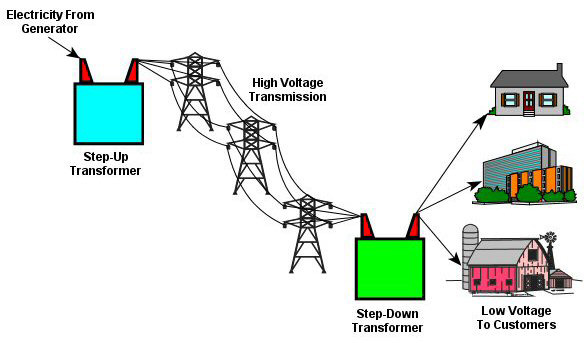To answer the question “What is the advantage of ac power transmission”, we need to know the characteristics of AC (Alternating Current) and its competitor, DC (Direct Current). AC is the current generated by the majority of power plants and is used in most power distribution systems. In contrast to direct current, the amperage path is repeatedly reversed per unit of time in alternating current.
The advantage of AC is that it is produced at a lower cost compared to DC and its losses in the long-distance distribution system are less than AC. However, for very great distances of more than 1000 km, DC can be a better choice.
Properties of AC
AC is an electric current whose path is reversed periodically, and its magnitude is constantly changing. This is exactly the opposite of DC, where its value and direction remain constant. Usually, the appliances we use in our homes and plug-in power outputs use AC power; Such as refrigerators, fans, air conditioners, televisions, and light lamps.
Most electrical circuits use sine wave AC. Half of the positive wave corresponds to the direction of the positive current and vice versa. Of course, there are some other waveforms, such as triangular or square, which are used in other electrical devices, such as electric guitar amplifiers. Some ACs, such as those employed in radio, are responsible for transmitting audio or image information by modulating the AC carrier signal at higher frequencies than the currents used in power transmission.
The figure below shows an AC sine wave and its characteristics, including 1) peak, 2) peak-to-peak, 3) effective value, and 4) period.
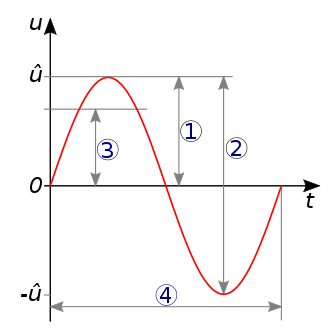
AC Current Voltage
Alternating currents are associated with alternating voltages. The sinusoidal alternating voltage is expressed mathematically by the following equation:
V_{t}=V_{p}sin(\omega t)
and
\omega =2\pi f
In the above equations, Vp is the maximum voltage in volts, ω is the angular frequency in the unit of radians per second, f is the physical frequency in hertz, and t is time in seconds.
Peak-to-peak AC voltage refers to the difference between the maximum and minimum of the AC voltage wave and is equal to:
V_{pp}=V_p-\left(-V_p\right)=2V_p
AC Current Power
The following relationship is established between voltage, load resistance, and power:
P\left(t\right)=\frac{v^2\left(t\right)}{R}
Due to the continuous change of AC voltage, Root Mean Square (RMS) is usually used to calculate the time-averaged power in the following equation:
P_{time\ averaged}=\frac{V^2_{rms}}{R}
The root means square of the voltage is calculated below:
V_{rms}=\sqrt{\frac{1}{T}\int^T_0{[v{\left(t\right)]}^2dt}}
Also, for the oscillating current, we have:
i\left(t\right)=\frac{v\left(t\right)}{R}=\frac{V_p}{R}{{sin}}\ \left(\omega t\right)\
So, for the power oscillation:
P(t)=v(t)i(t)=\frac{V_{p}^{2}}{R}sin^{2}(\omega t)
AC Current in Transmission
In this section, we will describe the answer to “What is the advantage of ac power transmission”. Electrical energy is distributed in the form of alternating current since AC voltage may be raised or reduced using a transformer. This system provides the condition for the power to be carried through power lines at high voltage efficiently, which decreases the energy loss because generated heat due to resistance of the wire and transformer drops to a lower level. So, it would be safer for use.
The use of greater voltages leads to the transmission of power more efficiently. The following formula describes the power loss in the wire:
P_{loss}=RI^2
In this relation, R and I represent the electrical resistance in ohms and current intensity in amperes, respectively. The above equation means that with transmitting a fixed value of power on a specific wire if we double the current (i.e., the voltage is halved), the electrical loss due to wire resistance quadruples.
The transmitted power is equal to:
P_{transmitted}=VI
Power is usually transmitted in hundreds of kilovolts on the pylon. Then, with transformers, they are reduced to tens of kilovolts to reach the transmission lines, and finally, with the help of transformers, they are reduced to 100 to 240 volts for home use.
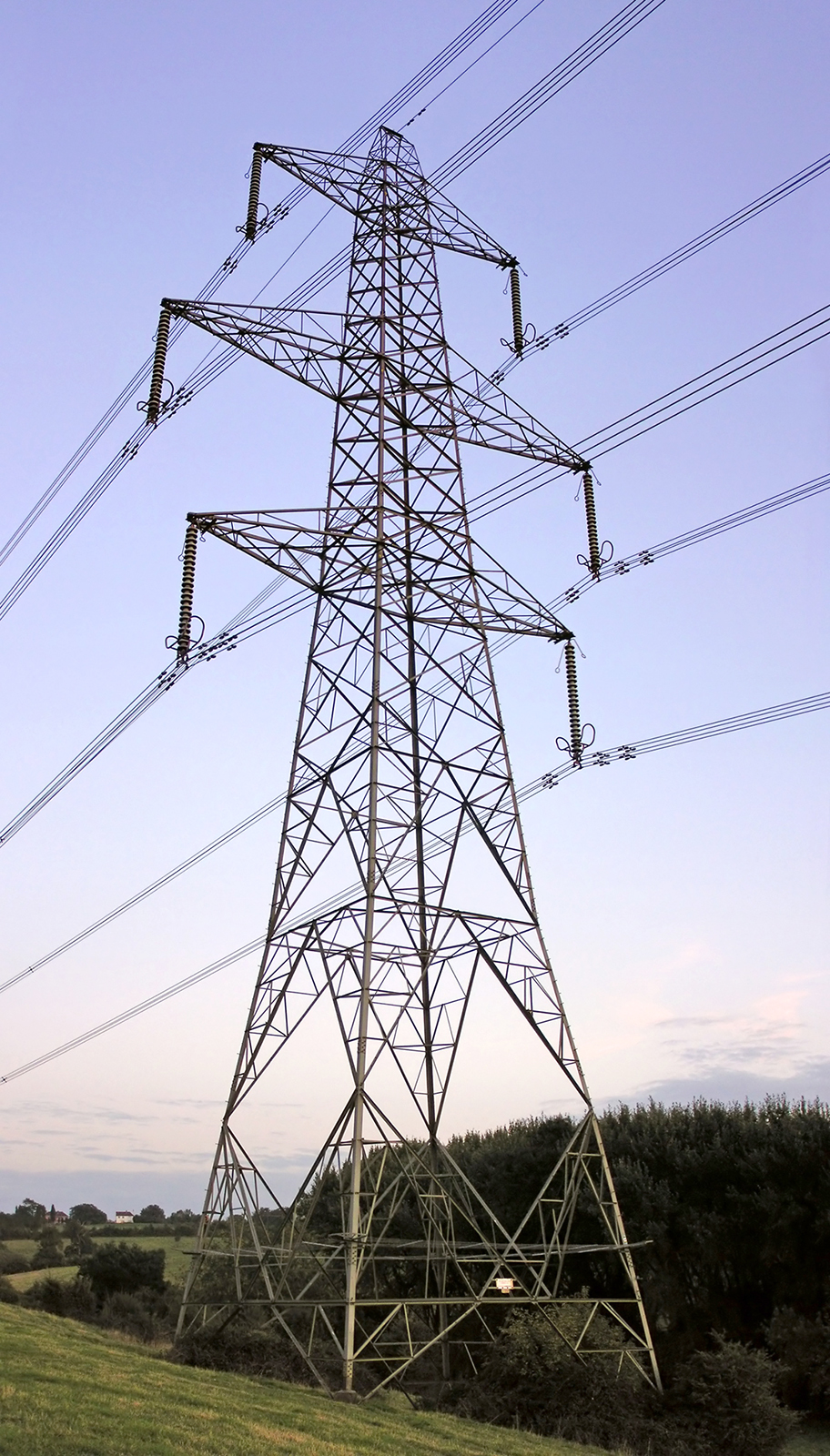
High voltages have drawbacks like the increased insulation needed and usually immerged difficulty in their protection handling. In a power plant, energy is produced at a suitable voltage for a generator’s working condition. Then, it is stepped up to a higher voltage to be transmitted. In the region of the loads, the voltage is stepped down to less voltage at an appropriate value for the devices.
The step-down voltage varies depending on the area where the electric charge consumer presents and the size of the load. However, motors and lights are embedded between the phases to use voltages in the hundreds of volts. Therefore, the voltage delivered to the devices is standardized to not cause problems for these devices. Standard power voltages and their tolerance differ in the various power systems around the world.
Transmission of high voltage direct current (HVDC) was impossible at the beginning of electric power transmission. There was no economically proper method to step down the DC voltage for user applications. But HVDC has made significant progress in recent years in recognizing new ways to change DC voltages. Therefore, AC is no longer the only way to transfer power, and the DC is used at high power transmission powers.
AC Current in Three-phase Transmission
Three-phase high-voltage transmission lines employ AC currents in power distribution over long distances between electric power plants and end-users. This is a common method of generating electricity in which three current waveforms are generated so that their magnitudes are equal, but 120° out of phase to each other.
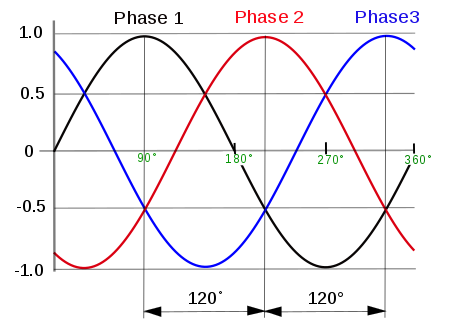
AC Frequencies
The frequency of the electricity system can vary from country to country and even within a country. Electric power is usually generated at a frequency of 50 or 60 Hz. A low frequency facilitates the design of electric motors. However, the low frequency also creates significant flicker in incandescent light bulbs and arc lamps. The use of lower frequencies also causes lower impedance losses proportional to frequency.
Some industries, such as aircraft, spacecraft, textile industries, marine applications, and the military, use 400 Hz; so, they benefit from weight reduction or higher engine speed. Computer systems are often designed with 400Hz or 415Hz for ripple reduction benefits while using small internal AC to DC converters.
High AC Frequencies
Despite the DC, which currents uniformly through a wire cross-section, an AC with any frequency is taken away from the center of the wire to its outer surface. The reason is due to the produced waves of electromagnetic radiation by the accelerated electric charge in an alternating current that negate the propagation of electricity to the center of high-conductivity materials. The name of this phenomenon is the “skin effect”.
At very high frequencies, the current does not tend to move inside the wire but on the surface. Even at relatively low frequencies used to transmit power, there is a non-uniform distribution of current in thick conductors. Therefore, high-current conductors are usually hollow to reduce cost and weight.
Since the current flows in the border of conductors, the effective conductor cross-section is decreased, leading to an increase in the conductor’s effective AC resistance according to the inverse proportion of resistance to the cross-sectional area. Sometimes, the AC resistance is much times greater than the DC resistance. So, it causes a much higher loss due to the ohmic heating described before.
This resistance can be reduced by dividing the conductors into several standard wires that are isolated from each other, called Litz wires.
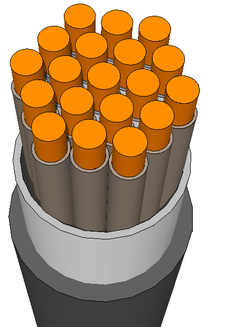
AC Current in Information Transmission
AC is utilized for information transmissions, such as in telephone and cable television. The signals are transmitted on a wide range of AC frequencies. The telephone signal frequency is about 3 kHz. Cable-transmitted information currents like the case of Cable television may have frequencies of tens to thousands of megahertz.
Conclusion
After the above explanations, we can briefly state the following in answer to the question of the advantage of ac power transmission.
- Most devices like large factory dynamos directly connected to the electric power grid run at alternating current. Electrical outlets in our homes and commercial centers use alternating currents as well. Appliances that need direct current, such as laptops, have an adapter to convert alternating current to direct current.
- AC power transmission is cheaper and more efficient in voltage stepping using transformers. This leads to efficient electrical energy transmission through power lines. This efficient transmission helps power companies and the consumer to save lots of money.
- Since power plants do not require compensating for lost electricity by using more fuel, AC reduces pollution.
- The cost of maintaining high-speed AC motors is low.
- Interruption of the current in an AC circuit is easy with a circuit breaker because the current naturally goes to zero every 1/2 cycle.
Buy Equipment or Ask for a Service
By using Linquip RFQ Service, you can expect to receive quotations from various suppliers across multiple industries and regions.
Click Here to Request a Quotation From Suppliers and Service Providers
Read More In Linquip

